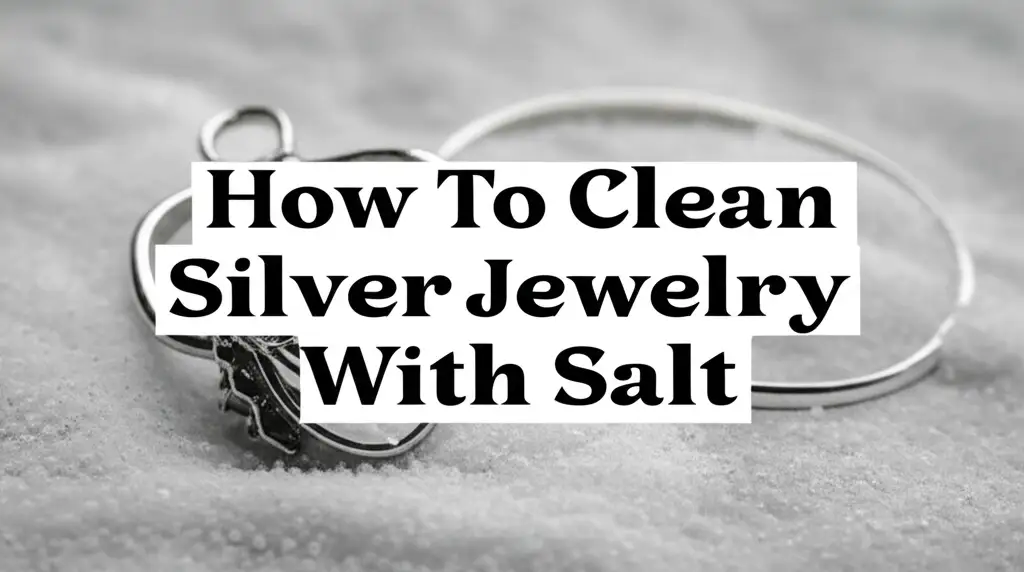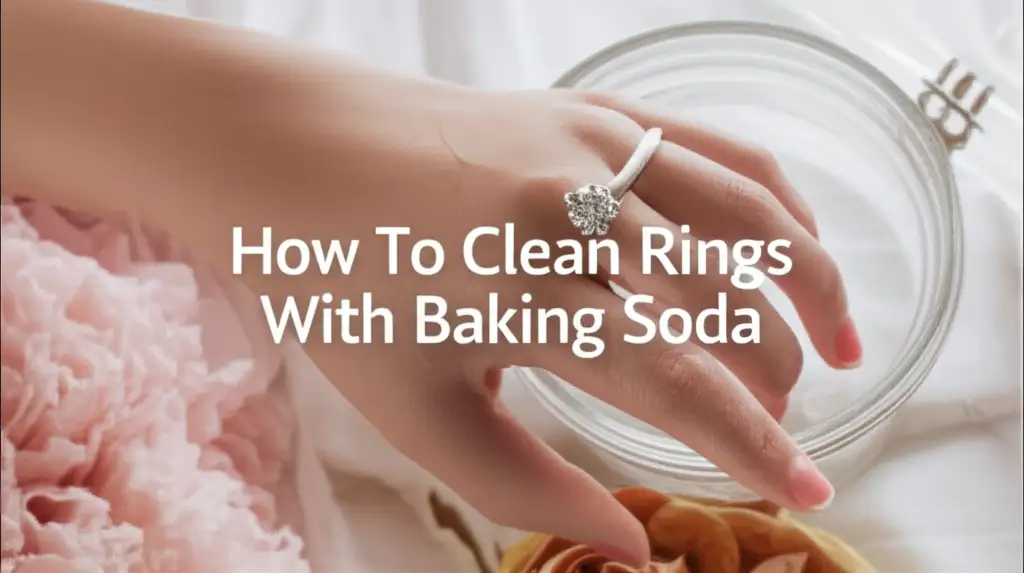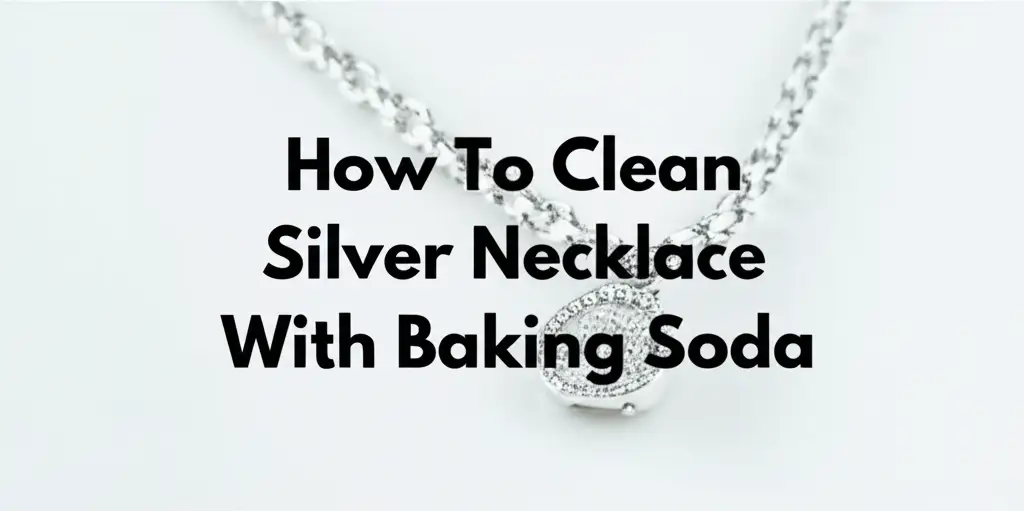· Jewelry Care · 15 min read
How To Clean Silver Jewlery With Salt

How To Clean Silver Jewlery With Salt
Tarnished silver jewelry often loses its beautiful shine. It can look dull and unappealing. Many people wonder about simple, natural ways to restore its sparkle. You might be surprised to learn that a common kitchen staple, salt, offers a powerful solution.
Learning how to clean silver jewelry with salt is simple. This method uses basic chemistry to reverse tarnishing. It avoids harsh chemicals, making it gentle on your precious pieces. In this guide, we will explore the science behind salt cleaning. We will provide detailed steps for various salt-based techniques. You will also find tips for proper care and when to avoid this method. Get ready to bring back the brilliant shine to your silver.
Takeaway
- Salt effectively removes tarnish from silver jewelry.
- Combine salt with aluminum foil and hot water for best results.
- The process is an electrochemical reaction, not abrasive cleaning.
- Always rinse and gently dry silver thoroughly after cleaning.
- Do not use this method on silver-plated items or pieces with delicate, porous stones.
Can I clean silver jewelry with salt?
Yes, you can clean silver jewelry with salt. When combined with aluminum foil and hot water, salt creates an electrochemical reaction. This process effectively reverses tarnishing by converting silver sulfide back to silver. It offers a gentle, natural way to revitalize your treasured pieces without harsh scrubbing.
Understanding Silver Tarnish and Salt’s Role
Silver jewelry gets its dark, dull look from a process called tarnishing. This happens when silver reacts with sulfur compounds in the air. These compounds are present in everyday things like pollution, rubber, and even some foods. This reaction creates silver sulfide on the surface of your jewelry. Silver sulfide is dark, and it makes your silver lose its shine.
Traditional cleaning often involves abrasive polishes. These polishes physically remove a tiny layer of silver. This can thin your jewelry over time. Salt offers a different approach. It uses a chemical reaction to lift the tarnish without scrubbing. This method is much gentler on your silver.
When you use salt with aluminum foil and hot water, a special process occurs. It is an electrochemical reaction. Aluminum is more reactive than silver. In the hot, salty water, aluminum acts as a “sacrificial metal.” The sulfur atoms prefer to bond with the aluminum rather than the silver. The salt water acts as an electrolyte. This helps the electrons move freely. The sulfur transfers from the silver sulfide back to the aluminum. This leaves your silver bright and clean again.
This reaction is safe for most solid silver items. It does not remove any metal from your jewelry. Instead, it converts the tarnish back into silver. This makes it a smart choice for maintaining your silver’s beauty for years. You are not scrubbing away the tarnish. You are reversing the chemical change. This method offers a low-cost, effective, and environmentally friendly way to care for your silver. It is a powerful example of simple chemistry at work in your home.
The Classic Salt and Aluminum Foil Method
This method is perhaps the most popular way to clean silver jewelry with salt. It relies on a simple chemical reaction. This reaction helps lift tarnish quickly and effectively. You will be amazed by the results. I find this method to be incredibly satisfying to watch.
Materials You Will Need:
- A bowl or dish: Choose one that can hold hot water. Glass or ceramic is best.
- Aluminum foil: Standard kitchen foil works perfectly.
- Non-iodized salt: Table salt is fine, but avoid iodized salt if possible. Iodine can sometimes leave spots on silver.
- Hot water: Very hot tap water is usually sufficient. Boiling water can also be used carefully.
- A soft cloth: Microfiber or cotton cloth for drying and polishing.
- Tongs or a slotted spoon: For safely removing hot jewelry.
Step-by-Step Instructions:
- Line the Bowl: First, line your chosen bowl completely with aluminum foil. Make sure the shiny side of the foil faces upwards. The foil needs to make good contact with the jewelry. This creates the necessary electrical circuit for the reaction.
- Add Salt: Sprinkle a generous amount of salt into the foil-lined bowl. Use about one to two tablespoons for an average-sized bowl. The salt dissolves in the water to create the electrolyte solution. This solution carries the electrical charge needed for the cleaning process.
- Place Jewelry: Carefully place your tarnished silver jewelry into the bowl. Make sure each piece touches the aluminum foil. If pieces do not touch the foil directly, they may not clean properly. You can gently move them around to ensure contact.
- Pour Hot Water: Slowly pour hot water over the jewelry. Use enough water to fully submerge all the silver pieces. You should see a slight fizzing or bubbling as the reaction begins. This is normal and means the cleaning process is working. The hotter the water, the faster the reaction.
- Let It Soak: Allow the jewelry to soak for 5 to 10 minutes. For heavily tarnished items, you might need to let them soak longer. You will actually see the tarnish moving from the silver onto the aluminum foil. The foil may turn dark as it collects the sulfur.
- Remove and Rinse: Carefully remove the jewelry using tongs or a slotted spoon. Be gentle, as the items will be hot. Rinse each piece thoroughly under cool, running water. This removes any salt residue and loose tarnish.
- Dry and Polish: Gently dry your silver jewelry with a soft, clean cloth. Buff it lightly to restore its full shine. You will notice a remarkable difference. The silver will look brighter and more lustrous. For more details on using this method effectively, read our guide on how to clean silver jewelry with aluminum foil. This method is incredibly effective for most solid silver pieces.
Enhancing the Clean: Salt with Baking Soda
While salt and aluminum foil work wonders alone, adding baking soda can boost the cleaning power. Baking soda is a mild abrasive. It also reacts with tarnish, helping to lift it away. This combination provides a more thorough clean for stubborn tarnish. I often turn to this duo for pieces that have been neglected for a while.
Baking soda, or sodium bicarbonate, is a gentle alkali. It can physically scrub away some surface grime. It also chemically reacts with acids and grease. When combined with salt, it enhances the electrochemical reaction. This makes the tarnish removal even more efficient. The mild abrasive quality helps to loosen stubborn spots. This ensures a brighter finish.
Method for Salt and Baking Soda:
- Prepare the Bowl: Line a non-metal bowl with aluminum foil, shiny side up. This is the same first step as the classic method. Ensure the foil covers the entire inside surface.
- Add Cleaning Agents: Sprinkle 1 tablespoon of salt into the bowl. Then add 1 tablespoon of baking soda. The combination of these two household items creates a strong cleaning solution.
- Place Jewelry: Place your tarnished silver jewelry on top of the foil. Make sure each piece touches the foil directly. Good contact ensures the chemical reaction works evenly across the surface.
- Pour Hot Water: Carefully pour enough hot water to cover all the jewelry. Use very hot tap water or freshly boiled water. You should observe fizzing. This indicates the cleaning process has begun. The heat speeds up the reaction, allowing the tarnish to lift more quickly.
- Soak Time: Let the jewelry soak for 5 to 15 minutes. For deeply tarnished items, you can extend the soaking time. Check the progress every few minutes. You will see the tarnish lifting. The aluminum foil will turn dark as it absorbs the sulfur compounds.
- Rinse and Dry: Remove the jewelry using tongs. Rinse it thoroughly under cool, running water. This washes away all cleaning solution residue. Dry the silver completely with a soft, lint-free cloth. A gentle buffing will reveal a beautiful, restored shine. For general tips on using baking soda for cleaning, you might find our article on how to clean shower with baking soda useful for understanding its broader applications, though specific to bathrooms. For cleaning silver necklaces specifically, this method works wonders, and you can find more targeted advice on how to clean silver necklace with baking soda.
This combined method is excellent for significant tarnishing. It provides a more robust cleaning action. Remember to always use non-iodized salt if possible to prevent any potential spots.
Cleaning Silver Jewelry with Stones and Delicate Details
Cleaning silver jewelry with stones requires special care. Some gemstones are soft. Others are porous. Salt and hot water can harm them. Glued settings can also weaken. You must know what type of stone your jewelry has. This prevents accidental damage.
Hard, non-porous stones like diamonds, sapphires, and rubies are generally safe. These stones can withstand the salt and hot water method. For example, if you have a silver ring with a diamond, you can typically use the salt and foil method. The diamond itself will not be harmed. The setting might need careful checking afterward to ensure no residue remains. Always make sure the stone is set firmly before you begin. For detailed advice on cleaning rings with various stones, consider reading our guide on how to clean silver rings with stones.
Softer or porous stones need more caution. Pearls, opals, turquoise, amber, and coral are delicate. They can absorb water or chemicals. This can cause them to crack, discolor, or lose their luster. The heat from the water can also cause damage. For these items, avoid full submersion in hot salt water.
Safe Cleaning for Delicate Pieces:
- Spot Cleaning: If only the silver parts are tarnished, try spot cleaning. Make a thick paste of salt (or salt and baking soda) with a tiny bit of water. Apply this paste only to the silver parts using a cotton swab. Keep it away from the stones. Let it sit for a few minutes. Then gently wipe it off with a damp cloth. This method limits contact with the stone.
- Quick Dip: For jewelry with slightly less delicate stones, you can try a very quick dip. Submerge the silver piece in the hot salt solution for only 30-60 seconds. Remove it immediately. Rinse thoroughly with cool water. This reduces the exposure time for the stones.
- Avoid Submersion: Never fully submerge pieces with glued-in stones. The hot water can weaken the adhesive. This makes the stones fall out. Items with enamel or other delicate finishes also need gentle handling.
- Professional Cleaning: When in doubt, seek professional advice. A jeweler can assess your piece. They can recommend the safest cleaning method. This is especially important for antique or valuable pieces.
Always prioritize the safety of your gemstones. A gentle approach protects your jewelry’s beauty. It also preserves its value.
Post-Cleaning Care and Tarnish Prevention
Cleaning your silver jewelry is only one part of maintaining its beauty. Proper post-cleaning care and smart storage prevent new tarnish from forming. This keeps your silver bright for longer periods. I always make sure to give my cleaned silver this extra attention. It truly makes a difference.
Rinsing and Drying Properly:
After any salt-based cleaning method, rinsing is critical.
- Rinse Thoroughly: Hold each piece under cool, running water. Make sure to rinse every crevice. This removes all traces of salt and tarnish residue. Leftover salt can corrode the silver over time.
- Dry Immediately and Completely: Use a soft, lint-free cloth to dry your silver. Microfiber cloths work best. Ensure the jewelry is completely dry before storing it. Any moisture left on the surface can encourage new tarnish. Air-drying is not recommended, as water spots can form.
Polishing Techniques:
Once dry, a light polish can enhance the shine.
- Soft Cloth Buffing: Gently buff your silver with a clean, dry polishing cloth. These cloths are often treated with a mild polishing agent. This removes any remaining haze. It also brings out a brilliant luster. Buff in small circular motions.
- Avoid Abrasives: Do not use abrasive cleaners or harsh cloths. These can scratch the silver surface. They can also remove tiny layers of metal.
Smart Storage for Tarnish Prevention:
How you store your silver greatly impacts how quickly it tarnishes.
- Airtight Containers: Store silver jewelry in airtight bags or containers. Ziploc bags or specialized jewelry boxes are excellent. This limits exposure to air and humidity, which cause tarnish.
- Anti-Tarnish Strips: Place anti-tarnish strips or silica gel packets with your silver. These absorb sulfur compounds and moisture. They create a protective environment. These small strips work wonders in preventing tarnish.
- Individual Storage: Store each silver piece separately. This prevents scratching. It also reduces the chances of tangling. Use soft pouches or individual compartments in a jewelry box.
- Avoid Humidity: Keep silver away from high humidity areas. Bathrooms are generally not good places to store silver. The moisture in the air speeds up tarnishing.
- Wear Your Silver: Surprisingly, wearing your silver regularly can help. The natural oils from your skin can create a protective barrier. However, avoid wearing silver while swimming in chlorinated pools or during activities where it might get damaged by harsh chemicals.
By following these simple post-cleaning and storage steps, you can keep your silver jewelry looking beautiful. You will enjoy its shine for much longer.
When to Avoid Salt for Silver Cleaning
While cleaning silver jewelry with salt is effective for many pieces, it is not always the best choice. Some types of silver or specific jewelry items require different care. Using salt on them could cause damage. It is important to know when to skip the salt method. I always check my pieces carefully before deciding on a cleaning approach.
Silver-Plated Items:
Salt and aluminum foil cleaning is generally not recommended for silver-plated jewelry. Silver-plated items have a thin layer of silver over a base metal. The electrochemical reaction can sometimes strip this thin silver layer. It can also cause discoloration or bubbling of the plating. The base metal underneath may show through. For how to clean silver-plated tea set or other plated items, gentle wiping with a soft cloth and mild soap is usually safer. This preserves the delicate plating.
Antique or Heavily Patinated Silver:
Antique silver often develops a beautiful, dark patina over time. This patina is not tarnish. It is a desirable oxidation that adds character and depth to the piece. Using the salt and foil method will remove this patina. This can significantly decrease the value and aesthetic appeal of antique items. Always consult an expert if you are unsure about cleaning antique silver. Preservation is key for these unique pieces.
Silver with Specific Finishes:
Some silver jewelry has intentionally oxidized or blackened finishes. This gives the piece a unique design. The salt method will remove these finishes. This will alter the intended look of your jewelry. If your silver has these deliberate dark areas, avoid the salt bath. Stick to gentle wiping for cleaning these pieces.
Heavily Oxidized or Pitted Silver:
For silver that is extremely tarnished, pitted, or has deep corrosion, the salt method may not be enough. It works best on typical surface tarnish. Severely damaged pieces might need professional cleaning or restoration. A professional jeweler has tools and solutions to safely address extensive damage. They can restore the piece without causing further harm.
Jewelry with Glued-in Stones or Organic Materials:
As mentioned earlier, hot water can weaken glue. This causes stones or other elements to fall out. Organic materials like pearls, coral, or amber are also very sensitive to heat and chemicals. They should never be put in hot salt water. Always hand-wipe these parts carefully.
By understanding these exceptions, you can protect your valuable silver. Choose the cleaning method that is appropriate for each specific piece. This ensures your jewelry remains beautiful and undamaged.
Frequently Asked Questions
Q1: Can salt damage silver jewelry?
Salt alone does not damage solid silver jewelry. When used with aluminum foil and hot water, the salt acts as an electrolyte. This helps the electrochemical reaction to remove tarnish. The process is non-abrasive. It is generally safe for solid sterling silver. However, avoid using it on silver-plated items or pieces with delicate, porous, or glued-in stones.
Q2: How often should I clean silver with salt?
Clean your silver jewelry with salt only when it shows signs of tarnish. You do not need to clean it daily or weekly. Over-cleaning is unnecessary. Regular storage in airtight bags with anti-tarnish strips can reduce how often you need to clean. Clean it as needed to restore its shine.
Q3: Is plain table salt okay to use?
Yes, plain table salt works well. However, non-iodized salt is preferred. Iodine in iodized salt can sometimes leave very faint spots or a dull finish on some silver. Most people use regular table salt without issues. For the best results, pick non-iodized salt if available.
Q4: What if my silver is still tarnished after cleaning?
If your silver is still tarnished after the salt method, it might be heavily oxidized. Try repeating the process with fresh water, salt, and foil. Increase the soaking time. For very stubborn tarnish, try adding baking soda to the salt solution. If tarnish remains, the item might need professional cleaning.
Q5: Can I clean silver with salt if it has diamonds?
Yes, you can generally clean silver with diamonds using the salt and foil method. Diamonds are hard and non-porous. They are not affected by hot water or salt. Ensure the diamond is securely set. Always rinse the piece thoroughly afterward. This removes any residue around the setting.
Q6: Does salt clean silver instantly?
The salt cleaning method works quite quickly. You will often see results within minutes. For light tarnish, it might take 2-3 minutes. Heavily tarnished items might need 10-15 minutes of soaking. You can observe the tarnish lifting onto the aluminum foil. The process is not instant, but it is fast.
Conclusion
Learning how to clean silver jewelry with salt provides a fantastic, natural solution for restoring its luster. This method offers a simple, cost-effective way to remove tarnish using common household items. You leverage basic chemistry, making it gentle on your precious silver without harsh abrasives. I find great satisfaction in seeing dull pieces transform back to their former glory.
By following the simple steps, especially the salt and aluminum foil technique, you can easily revitalize your favorite silver rings, necklaces, and bracelets. Remember to consider specific care for pieces with stones or delicate finishes. Proper post-cleaning care and smart storage also help keep your silver gleaming longer. Embrace this natural cleaning approach. Enjoy your sparkling silver jewelry for years to come.
- silver cleaning
- jewelry care
- home remedies
- salt cleaning
- tarnished silver




